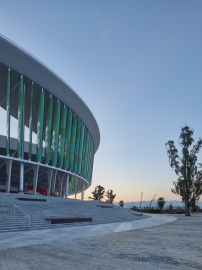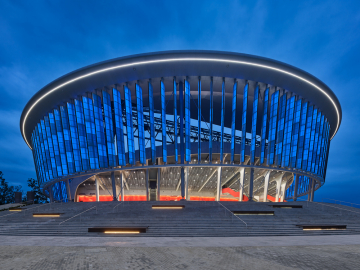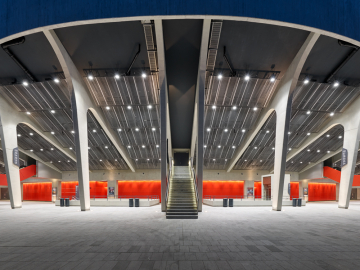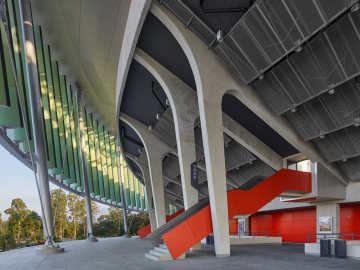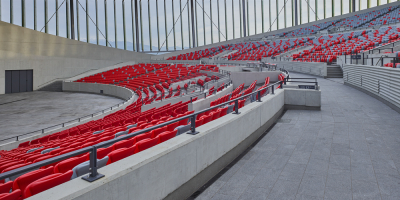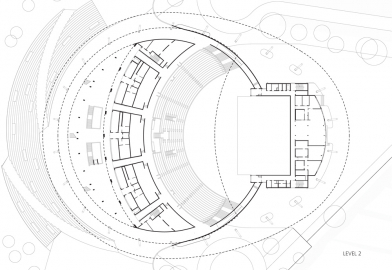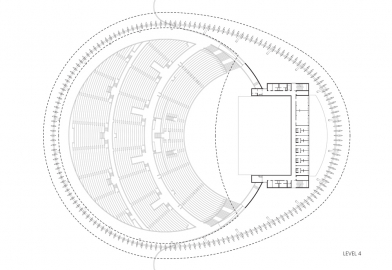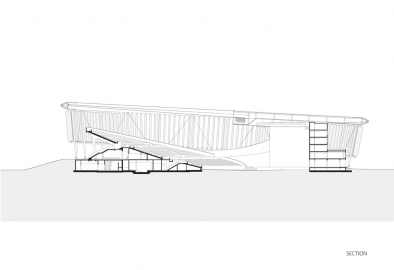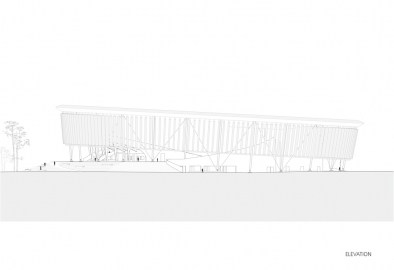Black Sea Arena
BLACK SEA ARENA – Multi-purpose venue for concerts and shows on the Georgian shores of the Black Sea as nucleus of further development of the region, designed as open-air space with adaptable roof and façade structures, capacity of approx. 9.000 visitors, planned and executed as part of a master plan with all necessary infrastructure and landscaping.
As part of a comprehensive scheme for economic and touristic development of the Georgian coastline, the charitable Association ATU erected a multi-purpose venue for 9.000 visitors on an empty field by the highway from Batumi to Poti, next to a small eucalyptus forest and only a short walk away from the beach. The main auditorium was requested as an open-air space, with adaptable roof and façade structures to provide shelter from rain and wind.
Due to its location, the project did not only call for an auditorium and its related functions such as lobbies, VIP areas, changing rooms and offices. In addition, all access streets, parking, vast landscaping, technical infrastructure as well as a warehouse for stage equipment and a fire station had to be developed.
The integration of this large-scale concept in its rural surroundings was a main goal in the design process.
The complex program was distributed between two separate buildings: the actual Black Sea Arena with its egg-shaped footprint for all visitors, artists and management, and a secondary building for the warehouse, the fire station and the main power and water supply.
The various parts of the arena were united under a slanting roof structure and a surrounding façade of vertical louvres. The closed green louvres create an abstract volume during the day, while their illumination with countless colours and patterns draws great attention in the evenings. The roof above the grandstands was planned with a slender compression ring and a completely retractable membrane roof. Together with the controllable louvres, this provided for the required adaptability to weather conditions.
All parts were to be designed and detailed according to German rules and regulations, while being executed on site by Georgian companies not experienced in this type of project. A very high overall standard was achieved in this process, but the adaptable roof structure was changed into a less minimalistic execution with movable but rigid sections by the client and his companies.
Due to a high earthquake risk, the grandstands with all levels below, as well as the 6-storey building behind the large stage were erected as stable concrete structures, whereas the main roof was built as lightweight steel structure with metal cladding. The rotating louvres were covered with translucent fibreglass panels.
While the exterior long-distance appearance is dominated by the colours green and silver, this changes into red and grey while approaching and entering the venue. The pavement of the large outside staircase with Georgian granite extends into all lobbies and the main circulation areas of the grandstands.
The mild climate does not require special attention to heat insulation, but all outside materials were chosen in regard to the high humidity, frequent rainfall and aggressive seaside atmosphere of the building site. High-quality exposed concrete could be executed instead of the locally typical plasterwork, so all surfaces can be effectively cleaned and maintained.
The considerable costs of the entire project were compensated by the qualification of Georgian firms, the benefits for the region, and the employment and training of locals.

